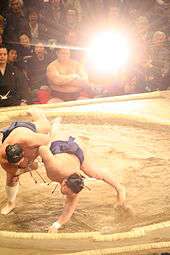Glare (vision)

Glare is difficulty seeing in the presence of bright light such as direct or reflected sunlight or artificial light such as car headlamps at night. Because of this, some cars include mirrors with automatic anti-glare functions.
Glare is caused by a significant ratio of luminance between the task (that which is being looked at) and the glare source. Factors such as the angle between the task and the glare source and eye adaptation have significant impacts on the experience of glare.
Discomfort and disability
Glare can be generally divided into two types, discomfort glare and disability glare. Discomfort glare results in an instinctive desire to look away from a bright light source or difficulty in seeing a task. Disability glare impairs the vision of objects without necessarily causing discomfort.[1] This could arise for instance when driving westward at sunset.
Disability glare is often caused by the inter-reflection of light within the eyeball, reducing the contrast between task and glare source to the point where the task cannot be distinguished. When glare is so intense that vision is completely impaired, it is sometimes called dazzle.[2]
Reducing factors
Glare can reduce visibility by:
- reduction of brightness of the rest of the scene by constriction of the pupils
- reduction in contrast of the rest of the scene by scattering of the bright light within the eye.
- reduction in contrast by scattering light in particles in the air, as when the headlights of a car illuminate the fog close to the vehicle, impeding vision at larger distance.
- reduction in contrast between print and paper by reflection of the light source in the printed matter (veiling glare).
- reduction in contrast by reflection of bright areas on the surface of a transparent medium as glass, plastic or water; for example when the sky is reflected in a lake, so that the bottom below or objects in the water cannot be seen (veiling glare).
- bloom surrounding objects in front of glare
Sunglasses are often worn to reduce glare; polarized sunglasses are designed to reduce glare caused by light reflected from non-metallic surfaces such as water, glossy printed matter or painted surfaces. An anti-reflective treatment on eyeglasses reduces the glare at night and glare from inside lights and computer screens that is caused by light bouncing off the lens. Some types of eyeglasses can reduce glare that occurs because of the imperfections on the surface of the eye.
Light field measurements can be taken to reduce glare with digital post-processing.
Measurement
Glare is typically measured with luminance meters or luminance cameras, both of which are able to determine the luminance of objects within small solid angles. The glare of a scene i.e. visual field of view, is then calculated from the luminance data of that scene.
The International Commission on Illumination (CIE) defines glare as:
visual conditions in which there is excessive contrast or an inappropriate distribution of light sources that disturbs the observer or limits the ability to distinguish details and objects.[3][4]
The CIE recommends the Unified glare rating (UGR) as a quantitative measure of glare.[5][6] Other glare calculation methods include CIBSE Glare Index, IES Glare Index and the Daylight Glare Index (DGI).[7]
Unified glare rating
The unified glare rating (UGR) is a measure of the glare in a given environment, proposed by Sorensen in 1987 and adopted by the International Commission on Illumination (CIE). It is basically the logarithm of the glare of all visible lamps, divided by the background lumination :[8]
where is the common logarithm (base 10), is the luminance of each light source numbered , is the solid angle of the light source seen from the observer and is the Guth position index, which depends on the distance from the line of sight of the viewer.
See also
- Afterimage
- Lens flare
- Lyot stop
- Over-illumination
- Specular reflection
- Visual comfort probability
- Selective yellow
References
- ↑ "CIE e-ILV: 17-330 disability glare". CIE.
- ↑ Schreuder, D. A. (1998). Road Lighting for Safety. London: Thomas Telford Publishing. p. 107. ISBN 0-7277-2616-1. Retrieved September 25, 2009.
- ↑ Murray Ian (12 October 2007). "Glare (C7654)". http://www.opticianonline.net. Retrieved October 29, 2012. External link in
|publisher=(help) - ↑ "Glare". http://www.cwct.co.uk. Retrieved October 29, 2012. External link in
|publisher=(help) - ↑ CIE 117-1995 Discomfort Glare in Interior Lighting. CIE. 1995. ISBN 978 3 900734 70 1.
- ↑ CIE 190:2010 Calculation and Presentation of Unified Glare Rating Tables for Indoor Lighting Luminaires. CIE. 2010. ISBN 9783901906879.
- ↑ "Glare". LEARN, Low Energy Architecture Research Unit. Retrieved October 29, 2012.
- ↑ Peter R. Boyce, "Unified+glare+rating" Human Factors in Lighting, 2nd edition, Taylor and Francis, London, 2003, p. 177